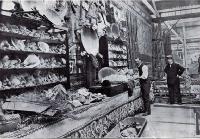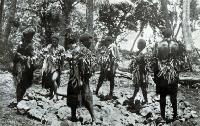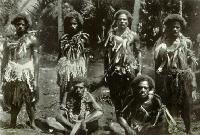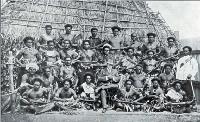Pacific Island Courts and Performances by Pacific Islanders at the Exhibition
- New Zealand’s Pacific neighbours were represented at the Exhibition by people of the Cook Islands, Fiji, Niue, and Hawai’i.
- They displayed traditional arts and crafts and performed their own style of song and dance, in some cases building traditional dwellings for the perusal of curious visitors.
Cook Islanders
By virtue of its inclusion within the boundaries of New Zealand in 1901, the Cook Island court was placed within the provincial courts exhibition area. It was very small but crammed with artefacts and curios, including weapons, mats, hats, drums, tapa cloth, wooden goods and a chief’s throne from Rarotonga. The largest and most attractive exhibits were 4 outrigger canoes, beautifully decorated with mother-of-pearl. One of these was purchased by the British commissioner, Captain Atkin, for the British Museum.
A party of 26 Cook Islanders, organised by Native Land Court judge H. Dunbar Johnson and led by Chief Makea Daniela, arrived in Christchurch to stay at Te Araiteuru Pa on the day before the Exhibition opened. There were 13 men and women from Rarotonga, 7 from the island of Mangaia and 6 from the island of Aitutaki. The group gave a number of public performances, with action-songs, rhythmic drumming, and dances, and their part-singing harmonies were especially attractive to visitors. One admirer wrote that "Only the people of coral lands can sing as they sang … now like flutes, … now like the notes of a guitar … now like a sweet and deep-toned bell".1 Much comment was also made about the bark tapa-cloth fete dresses which were worn by the women. The Māori inhabitants of the Pa were also fascinated by the visitors, whose customs and traditions were so similar to their own. The Cook Islanders left Christchurch to return home on 11 January 1907.
Fijians
The Fijian Court at the Exhibition displayed such products as cotton (several cotton trees were transplanted and "made to appear in all their original glory of festooning white"2), peanuts, vanilla, spices, tobacco, cocoa beans, coffee, copra, cordage made from coconut husk and the Islands’ staple industry, sugar (the exhibit of the Colonial Sugar Refining Company was right next to the Court). There was also a magnificent collection of shells and various native products, such as model canoes, woven mats and baskets, clothing including tapa-cloth, weapons, and timbers.
Fiji sent two parties of entertainers to the Exhibition. A group of 25 men arrived on 15 November 1906, led by Ratu Ifereimi. They built a large Fijian-style thatched house in the grounds of the Pa, where they resided during the Exhibition. The Māori and Cook Island occupants held a ceremonial welcome for the Fijians on 6 December. The group gave several public performances of fan, spear and club dances, and also held kava-drinking ceremonies. The greatest excitement, however, was reserved for the second group of Fijians, who arrived on 13 December. They were 26 firewalkers of the Sawau tribe from the island Benga, led by Kalebi. The firewalkers gave four public performances, the first on 17 December, and these were attended by large, enthusiastic crowds who were "intensely interested"3 in the display.
Niueans
A small group of three men, two women and a child were the visitors from Niue at the Exhibition. They were led by Frank Fataaiki, whose wife gave birth to a son while they were in Christchurch. This was the second birth at the Pa, a Māori woman having given birth earlier. The Niueans occupied a little kainga of their own alongside the Māori Pa, where they built a Niuean thatched dwelling, using materials brought from home. Because the group was so small, they gave no public performances but sold their plaited hats, fans, and model outrigger canoes through the Cook Islands Court. They wore European dress, and from accounts of the time were "thoroughly civilised-looking"4, no longer the "Savage Islanders"5 who once attacked Captain Cook and others.
Hawaiian Exhibit
This exhibit was part of the Fijian Court and was "typical of native life in the Islands".6 Products included coffee, rice, taro, sisal, rubber and tobacco. Of particular interest were feather leis made from the feathers of extinct birds. The display also included photographs of Hawaiian scenery and native music.
![]()
Related photos
Sources
- Cowan, J. Official record of the New Zealand International Exhibition of Arts and Industries held at Christchurch, 1906-7, page 353-375
- "The Fiji Court", Canterbury times, 7 November 1906, p. 30
- "The Hawaiian Exhibit", The Weekly Press, 7 November 1906, page 110




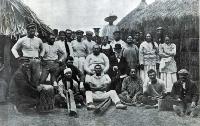
![The village. The Cook Islanders at the Exhibition [1906]](/Heritage/Photos/Disc20/Thumbnails/IMG0004.jpg)

